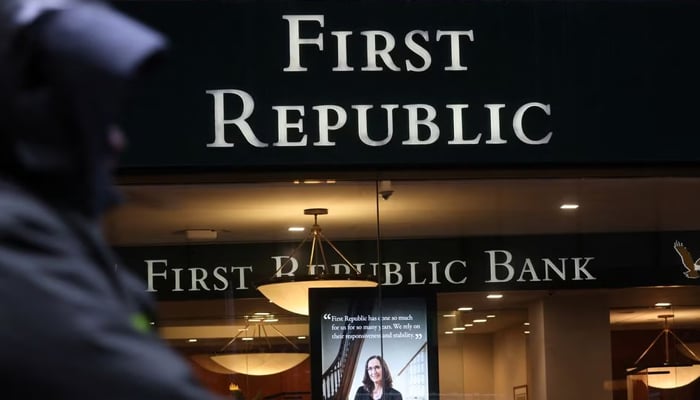A $30 billion lifeline for First Republic Bank hosed down market fears about an imminent banking collapse on Friday, but a late tumble in the troubled US lender’s shares showed investors were still worried about cracks in the sector.
Large US banks injected the funds into Silicon Valley Bank on Thursday, swooping in to rescue the lender caught up in a widening crisis triggered by the collapse of two other mid-size US lenders over the past week.
The deal was put together by top power brokers including US Treasury Secretary Janet Yellen, Federal Reserve Chairman Jerome Powell and JPMorgan Chase CEO Jamie Dimon, who had discussed the package this week, according to a source familiar with the situation.
The package came less than a day after Swiss bank Credit Suisse clinched an emergency central bank loan of up to $54 billion to shore up its liquidity.
Those deals helped restore calm to global markets on Thursday and Friday, following a torrid week for banking stocks.
However, while First Republic’s stock closed up 10% on news of the rescue, its shares fell 17% in after-market trading after the bank said it would suspend its dividend and disclosed its cash position and just how much emergency liquidity it needed.
Analysts say authorities appear eager to quickly deal with systemic risks, but worry the potential for a banking crisis is far from over.
“They will keep the money in the First Republic to keep it alive for self-interest… to stop the run on banks. Then they will take it away gradually and the bank will play out a slow death,” said Mathan Somasundaram, founder at research firm Deep Data Analytics in Sydney.
“Yellen was clear overnight that all bank deposits were protected, but the bank might not be there,” he said.
Some of the biggest US banking names including JPMorgan Chase & Co, Citigroup Inc, Bank of America Corp, Wells Fargo & Co, Goldman Sachs and Morgan Stanley were involved in the rescue, according to a statement from the banks.
While the support has prevented an imminent collapse, investors were startled by late disclosures about First Republic’s cash position, even after the injection, and just how much it and others leaned on the Fed this month for support.
Data on Thursday showed banks in the United States sought record amounts of emergency liquidity from the Fed in recent days, driving up the size of the central bank’s balance sheet after months of contraction.
More broadly, worries about contagion risks persist.
“I don’t think we are in the crux of a global financial crisis. Balance sheets are much better than they were in 2008, and banks are better regulated,” said Karen Jorritsma, head of Australian equities at RBC Capital Markets. “But people are concerned that the contagion risk is real, and that rattles confidence.”
What lessons can be learned from 2008 financial crisis?
For now, authorities are confident the banking system is resilient and have tried to emphasise that the current turmoil is different to the global financial crisis 15 years ago as banks are better capitalised and funds more easily available.
On Thursday, the European Central Bank pressed forward with a 50-basis-point rate hike, arguing that eurozone banks were in good shape and that if anything, the move to higher rates should bolster their margins.
Focus now swings to the Fed’s policy decision next week and whether it will stick with its aggressive interest rate hikes as it seeks to get inflation under control.
In Asia, Singapore, Australia and New Zealand said they were monitoring financial markets but were confident their local banks were well-capitalised and able to withstand major shocks.
While capital remains adequate, analysts say a A$300 billion ($201 billion) refinancing task for Australia’s biggest banks is about to get harder, as appetite for new debt shrinks across global markets.
Japan’s finance ministry, financial regulator and the central bank said they would meet on Friday to discuss financial market developments.
Banking stocks globally have been battered since Silicon Valley Bank collapsed last week due to bond-related losses that piled up when interest rates surged last year, raising questions about what else might be lurking in the wider banking system.
Within days, the market turmoil had ensnared Credit Suisse, forcing it to borrow from Switzerland’s central bank.
By Thursday, the spotlight whipsawed back to the United States as big banks shored up support for First Republic, a regional lender. Its shares have dropped more than 70% since March 6.
Credit Suisse became the first major global bank to take up an emergency lifeline since the 2008 financial crisis as fears of contagion swept the banking sector and raised doubts over whether central banks will be able to sustain aggressive rate hikes to rein in inflation.
Andre Helfenstein, the head of the group’s Swiss operation, said on Thursday he saw the central bank funding as “precautionary liquidity” to allow the embattled lender to continue its revamp.
Rapidly rising rates have made it harder for some businesses to pay back or service loans, increasing the chances of losses for lenders already worried about a recession.
Credit Suisse shares closed 19% higher on Thursday, recovering some of their 25% fall on Wednesday. Since March 8, European banks have lost around $165 billion in market value, Refinitiv data shows.


